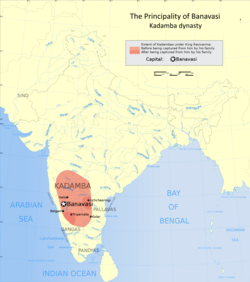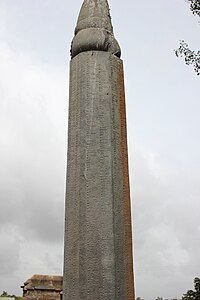
Back سلالة كادامبا الحاكمة Arabic কদম্ব রাজবংশ Bengali/Bangla Dinastia Kadamba Catalan Kadamba German Dinastía Kadamba Spanish कदंब राजवंश Hindi Kadamba (famiglia) Italian კადამბა (დინასტია) Georgian ಕದಂಬ ರಾಜವಂಶ Kannada 카담바 왕조 Korean
Kadambas of Banavasi Banavasi Kadambaru | |||||||||||
|---|---|---|---|---|---|---|---|---|---|---|---|
| 345 CE–540 CE | |||||||||||
 Extent of Kadambas, 500 CE | |||||||||||
| Capital | Banavasi | ||||||||||
| Common languages | Sanskrit Kannada | ||||||||||
| Religion | Hinduism Jainism[1][2] | ||||||||||
| Government | Monarchy | ||||||||||
| Maharaja | |||||||||||
• 345–365 | Mayurasharma | ||||||||||
• 516-540 | Krishna Varma II | ||||||||||
| History | |||||||||||
• Earliest Kadamba records | 450 CE | ||||||||||
• Established | 345 CE | ||||||||||
• Disestablished | 540 CE | ||||||||||
| |||||||||||
| Today part of | India | ||||||||||
| Kadamba dynasty |
|---|


The Kadambas were an ancient royal family from modern Karnataka, India, that ruled northern Karnataka and the Konkan from Banavasi in present-day Uttara Kannada district in India. The kingdom was founded by Mayurasharma in c. 345, and at later times showed the potential of developing into imperial proportions. An indication of their imperial ambitions is provided by the titles and epithets assumed by its rulers, and the marital relations they kept with other kingdoms and empires, such as the Vakatakas and Guptas of northern India. Mayurasharma defeated the armies of the Pallavas of Kanchi possibly with the help of some native tribes and claimed sovereignty. The Kadamba power reached its peak during the rule of Kakusthavarma.
The Kadambas were contemporaries of the Western Ganga Dynasty and together they formed the earliest native kingdoms to rule the land with autonomy. From the mid-6th century the dynasty continued to rule as a vassal of larger Kannada empires, the Chalukya and the Rashtrakuta empires for over five hundred years during which time they branched into minor dynasties. Notable among these are the Kadambas of Goa, the Kadambas of Halasi and the Kadambas of Hangal. During the pre-Kadamba era the ruling families that controlled the Karnataka region, the Mauryas and later the Satavahanas, were not natives of the region and therefore the nucleus of power resided outside present-day Karnataka. The Kadambas were the first indigenous dynasty to use Kannada, the language of the soil, at an administrative level. In the History of Karnataka, this era serves as a broad-based historical starting point in the study of the development of the region as an enduring geo-political entity and Kannada as an important regional language.
© MMXXIII Rich X Search. We shall prevail. All rights reserved. Rich X Search